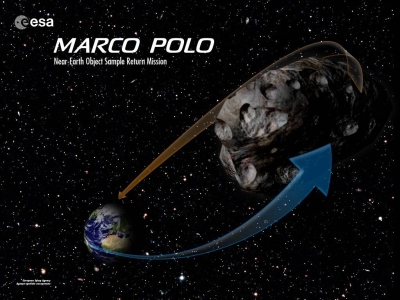
From the announcement of the Marco Polo Workshop, a short overview of the Marco Polo mission. Please see the announcement that follows as well as the links for the presentations given at the June 2008 Workshop. Some interesting points observed from the presentations include that NASA is potentially interested in contributing to Marco Polo as a Mission of Opportunity ($35M). This comes from the OSIRIS mission overview presentation (available at the workshop site, see link below).
From the overview of the June 2008 Workshop, there is a good overview of the Marco Polo mission...
Marco Polo is a Near-Earth Object sample return mission studied within the Cosmic Vision programme. It was proposed by Antonella Barucci and a team of several hundred scientists in Europe to ESA in 2007 and is currently undergoing an assessment study.
Marco Polo was proposed in response to ESA's call for mission proposals as part of the new Cosmic Vision programme, suggesting missions with a launch date between 2015 and 2025. The lead proposers are Antonella Barucci from the Observatoire de Paris-Meudon and M. Yoshikawa from the Japanese space agency JAXA. They were supported by a core team of six scientists in Europe, two scientists in Japan, and one in the USA. A total of 436 scientists from countries all over the world support the proposal.
Small bodies in the solar system are leftover building blocks of the formation of the solar system. They offer clues to the chemical mixture from which the planets formed some 4.6 billion years ago. Also, current exobiological scenarios for the origin of life invoke an exogenous delivery of organic matter to the early Earth: it has been proposed that primitive bodies could have brought these complex organic molecules capable of triggering the pre-biotic synthesis of biochemical compounds on the early Earth. Moreover, collisions of NEOs with the Earth pose a finite hazard to life. For all these reasons, the exploration of such objects is particularly interesting and urgent.
The principal scientific objective of the Marco Polo mission is to return unaltered material from a NEO, for analysis in terrestrial laboratories, thereby obtaining measurements that cannot yet be performed from a robotic spacecraft (e.g. dating the major events in the history of a sample).
Moreover, the mission will enable us to:
1. Determine the physical and chemical properties of the target body, which are representative of the planetesimals present in the early solar nebula
2. Identify the major events (e.g. agglomeration, heating, aqueous alteration, solar wind interaction) which influenced the history of the target
3. Determine the elemental and mineralogical properties of the target body and the geological context of the surface
4. Search for pre-solar material yet unknown in meteoritic samples
5. Investigate the nature and origin of organic compounds on the target body
6. Identify organic compounds which may reveal the origin of pre-biotic molecules
7. Understand the role of minor body impacts in the origin and evolution of life on Earth
Link: Marco Polo June 2008 Workshop Announcement
Link: June 2008 Workshop Presentations
Link: LPSI Abstract on Marco Polo Mission - PDF

No comments:
Post a Comment